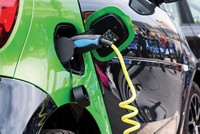Advertisement
Grab your lab coat. Let's get started
Welcome!
Welcome!
Create an account below to get 6 C&EN articles per month, receive newsletters and more - all free.
It seems this is your first time logging in online. Please enter the following information to continue.
As an ACS member you automatically get access to this site. All we need is few more details to create your reading experience.
Not you? Sign in with a different account.
Not you? Sign in with a different account.
ERROR 1
ERROR 1
ERROR 2
ERROR 2
ERROR 2
ERROR 2
ERROR 2
Password and Confirm password must match.
If you have an ACS member number, please enter it here so we can link this account to your membership. (optional)
ERROR 2
ACS values your privacy. By submitting your information, you are gaining access to C&EN and subscribing to our weekly newsletter. We use the information you provide to make your reading experience better, and we will never sell your data to third party members.
Environment
A Local Look At Plug-In Vehicles
Study finds regional variance in impact of electric cars
by Jeff Johnson
April 30, 2012
| A version of this story appeared in
Volume 90, Issue 18
Do plug-in electric vehicles make economic and environmental sense?
The answer is mostly yes, if you look only at fuel costs and where the vehicles are charged, according to a report released on April 16 by the Union of Concerned Scientists (UCS), a science-based environmental nonprofit organization. The importance of this question, the group argues, is likely to grow for two reasons.
First, more plug-in electric vehicles will be on U.S. roads because nearly all automakers are planning to make them. It is unclear how many electric cars there are currently, but according to a February 2011 Department of Energy report, about 45,000 were expected to be manufactured last year. President Barack Obama is also pushing to get 1 million of them on the road by 2015.
Second, electrical utilities are slowly moving to better pricing options that could lower the cost of charging an electric car. Utilities are also shifting to cleaner fuels, thus improving the environmental footprint of electric cars.
The UCS study looks at the climate-change impact of electric vehicles according to the type of fuel used to generate electricity in different regions of the U.S. The report divides the nation into 26 regions, reflecting the blend of fuel sources used for electricity—coal, natural gas, nuclear, and renewables.
For example, vehicles charged in regions that rely more on natural gas than coal to generate electricity will produce less carbon dioxide, a greenhouse gas. If the trend away from coal continues, plug-in vehicles will have the unique distinction among automobiles of producing fewer emissions as they age, notes Don Anair, the report’s coauthor and senior engineer with UCS’s Clean Vehicles Program.
In regions where electricity comes from a mix of fuel sources—such as much of the West and parts of the eastern seaboard—emissions and operating costs strongly favor electric vehicles, the report finds. For instance, in California and New York, electric vehicles would be equivalent to a hypothetical gasoline-powered, 80-mpg vehicle in emissions and environmental performance.
The worst ratings, according to the report, will be in some Rocky Mountain and midwestern states. These regions depend more on coal-fired power plants for electricity. As a result, in these states greenhouse gas emissions from electric vehicles will be higher than in other regions, and electric vehicles’ performance can match only those of a 33-mpg vehicle.
In terms of fuel costs based on electricity rates in 50 U.S. cities, the report finds that electric-vehicle drivers will spend $750 to $1,200 less per year than will drivers operating an average new compact vehicle fueled by gasoline costing $3.50 per gal.
Right now, timing of the charge doesn’t matter much, the report says. But as utilities begin basing electricity rates on demand and allowing time-of-use pricing, when charging takes place will affect cost, Anair notes.
San Diego Gas & Electric, Anair says, is undertaking a pilot program to allow a small group of residents to install separate meters for the electric vehicles and pay reduced rates if they charge their vehicles between midnight and 5 AM.




Join the conversation
Contact the reporter
Submit a Letter to the Editor for publication
Engage with us on Twitter